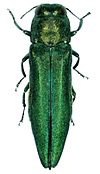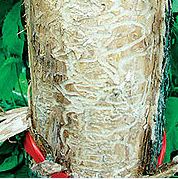14 Jun Emerald Ash Borer: what you need to know.
Last week our community was in an uproar when the official announcement from the Nebraska Department of Agriculture confirmed Emerald Ash Borer (EAB) was discovered in Pulsaki Park on June 6, 2016. Many landscape, nursery, and tree service companies have been on the look-out for the arrival of EAB due to its confirmed presence in surrounding states such as Iowa, Missouri and Kansas and its killing of 50 million ash trees in the United States altogether. Nebraska has now been named the 27th state to confirm the infestation of EAB. We, as a state, were devastated to learn of it’s arrival, however there are prevention and treatment options available for ash tree homeowners. Here’s what you need to know…

Appearance of EAB:
- Green beetles the size of 1/2 inch long
- Larvae are cream colored with brown heads, the size of 1 1/4 inch long

Ash Tree symptoms:
- Canopy thinning
- Branch death starting at the top of the tree
- Bark splitting
- Zigzag tunnels below bark
- D-shaped exit holes roughly 1/8 inch in diameter, which causes bark to strip
Note: just because your tree markets these symptoms, does not guarantee it’s infected from EAB. There are several insects in Nebraska that cause these symptoms. Contact your local certified arborist for diagnosis.
Infected Ash Tree: to treat or remove?
Once your ash tree has been identified as EAB infected, it’s important to ask yourself, is the tree a healthy, high-value tree that is in a good location? (Note: trees next to buildings and power lines do not qualify as ideal locality)
- If you answered yes, you need to provide treatment to prevent or eradicate the borer. Your first step is to contact a certified arborist.
- We recommend Mutchie Tree Services: 402-991-1713
- If you answered no, this tree is not valuable or a young specimen, then it’s time to remove them from your landscape and replace with a new tree. In which case, after you have contacted your certified arborist for removal, call Sun Valley Landscaping to schedule your tree replacement!
EAB treatment
- Treatment available for homeowners is a soil application of imidacloprid- most commonly effective for small trees less than 15 inches in diameter
- Soil treatments are applied as an injection to the soil and is then distributed throughout the tree
- Certified Tree Specialists have 2 treatment options
- Trunk Injections- recommend treatment because it is digitally engineered and distributed so the exact amount of insecticide is injected in the tree stump (Injection lasts 2 years), however it is a slower therapy that prevents EAB eggs from hatching
- Bark and Foliage Spray-
- Bark sprays protect Ash Tree branches & trunk so they aren’t attacked by new EAB
- Foliage sprays control adult beetles and must be sprayed in early spring, be cautious with children and pets as they can be exposed to spray
- Spray applications last 1 year and are the quickest therapy for infected Ash Trees
- For more information on understanding and choosing professional treatments, click here!
How is EAB spread?
- Through the transferring of infected firewood or nursery stock
- To avoid spreading, purchase firewood at location of use (i.e. do not travel with leftover firewood from campsites)
Does EAB affect all ash trees?
- EAB affects all Northern American species of ash (including white, green, and black ash)
Who should I contact if I have questions regarding EAB and tree diagnosis?
- Nebraska Department of Agriculture – 402-471-2351
- Brian Mutchie- 402-991-1713


